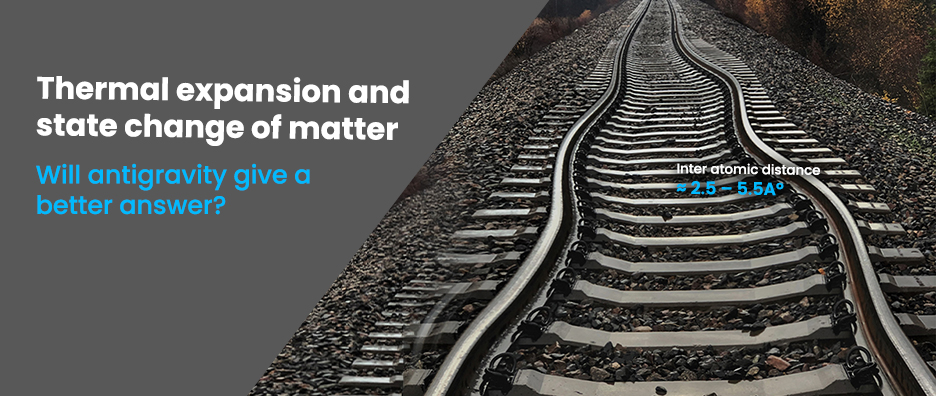
Convection – Rising heated air molecules
Convection – Rising heated air molecules According to the existing definition: Convection is the transfer of heat vertically from one place to another, by bulk


A given atom may rest in its equilibrium position, r0, i.e., at the minimum of potential energy. If, however, the temperature is raised, the amplitude of the vibrating atom increases, too. Since the amplitudes of the vibrating atom are symmetric about a median position and since the potential curve is not symmetric, a given atom moves farther apart from its neighbor, i.e., the average position of an atom moves to a larger r, say, r2, as shown in Figure 1 (anharmonicity (Xiangliang et al., 2009)). In other words, thermal expansion is a direct consequence of the asymmetry of the potential energy curve. The same arguments hold true if all atoms in a solid are considered.

1.Do fundamental forces depend on temperature?
According to existing theories, there are only four types of fundamental forces:
To retain the atoms of a solid together, there should be an attraction among them. At interatomic distances (≈ 3×10-10 m) in solid matter, subatomic strong and weak forces do not apply because such forces are limited to subatomic distances (≈ 1×10-15 m). Therefore, according to existing theory, only the gravitational force and the electromagnetic force are available at interatomic distances, to retain together the atoms of the solid.
According to the existing definitions, gravitational forces and electromagnetic forces do not depend on temperature. Therefore, they should remain constant with the increment of temperature.
2.Is Interatomic Bonding Potential Related to Temperature?
Existing theories discuss Bonding Potential V(r) as depicted by Lennard-Jones potential curve:

where, r is the distance between two interacting particles, ε is the depth of the potential well (usually referred to as ‘dispersion energy’), and σ is the distance at which the particle-particle potential energy V is zero (often referred to as ‘size of the particle’).
It could, nevertheless, be observed that Lennard-Jones potential curve is not temperature dependent!
3.Does Entropy Explain Thermal Expansion?
Another explanation for the thermal expansion is available in the literature using thermodynamics. Entropy is a measure of the random activity in a system, which increases with the rise of the temperature and trends molecules to separate from each other. This is given as a cause of thermal expansion.
Reason for the increment of the entropy (random activity) of a system when we input more energy, is not explained. This perspective explains neither the mechanism of increasing entropy nor the mechanism of thermal expansion.
Summary of Challenges in Existing Theories:
Neither fundamental forces nor potential energy depend on temperature. There is no mechanism to explain how increase in energy increases entropy or how increase in entropy causes thermal expansion.
It’s obvious that some kind of force is needed to increase the distance between two atoms which are attracted to each other. In the existing theories we feel an absence of a force which increases with the temperature.
By assuming a gravitational repulsion force, in addition to the gravitational attraction force, thermal expansion can easily be explained.
As gravitational attraction is caused by the mass, the gravitational repulsion is caused by the thermal energy. Please see Figure 2.

A new fundamental force is introduced: Gravitational Repulsion Force (also called Antigravity), which is always repulsive and proportional to the thermal energy of the matter. With the increment of temperature (a manifestation of thermal energy) gravitational repulsion force is increased, causing the distance between atoms/molecules to be increased.
If the attraction forces (gravitational force + electromagnetic force) are higher than the gravitational repulsion force, the interatomic/intermolecular bonds will remain unbroken and we observe thermal expansion of matter with increment of temperature.
State Change of Matter:
As discussed above, the temperature in matter changes, gravitational repulsion force also changes. The latter affects interatomic/intermolecular distance, resulting in change of interatomic/intermolecular bonds. State change (melting, boiling, condensation, freezing, sublimation) of matter happens based on how the magnitude of gravitational repulsion force compares with that of the gravitational attraction force. This phenomenon is discussed under a separate topic: “State Change of Matter”.
References :

Convection – Rising heated air molecules According to the existing definition: Convection is the transfer of heat vertically from one place to another, by bulk

Upward motion of condensed water droplets in still air Upward motion of water droplets when not supported by convection currents has been observed (Piyadasa, 2012),

Upward motion of mercury molecular clusters at room temperature Experimentally verified following observations cannot be explained by existing theories! They could, nevertheless, be easily explained